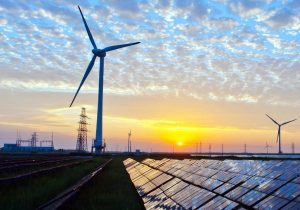Red states among renewable energy leaders
CLEAN ENERGY
By: Kavya Balaraman, E&E News reporter
Published: Thursday, April 20, 2017
Wyoming might be in coal country, but it’s also leading the country in renewable energy capacity, a new report finds.
Wyoming’s expanding wind sector has placed it at the top of a ranking of states’ clean energy development by the Union of Concerned Scientists. The report found that renewable sources account for all of the new power plant capacity added to the state between 2016 and 2019. Wyoming also leads in terms of renewable energy development per capita.
“If you look at Wyoming, you might think about coal. But it tops all our metrics that look at new capacity, what’s being built in each state in the near future and the percentage of renewable energy in what they’re building overall,” said John Rogers, energy analyst with UCS and the lead author of the report.
The ranking used a combination of metrics along with renewable energy development, including technical processes, energy efficiency, electrification of vehicles, job creation and pollution reduction. Many of the findings were predictable — California topped the list, signifying that it’s furthest along on the fossil-fuel-to-clean-energy transition. Vermont and Massachusetts are ranked second and third, respectively.
However, the ranking also throws up some surprises: Kansas is first for increasing its share of renewable energy in electricity (it tripled its wind power in four years), and North Dakota led in terms of wind energy per capita.
A combination of drivers could account for the success of renewable energy in a particular state, said Rogers. Market forces play a huge role, especially as clean energy becomes cheaper and more efficient. But policy is also important, both at the state and federal level. Very few states made it into the top 10 without some kind of strong energy efficiency resource standard or climate target, and these included states led by Republicans and Democrats.
“When we tallied the top 10 states, we found six headed by Democrats and four by Republicans,” said Rogers. “Leadership doesn’t have to be a red state-blue state thing. Wherever they live and whichever party they vote for, people care about jobs and clean air.”
Federal policy plays a role, too, especially in terms of ensuring that access to renewable energy is equitable. However, Roger points out that there’s only so much the Trump administration can do to slow the growth of renewables.
“The move to clean energy is unstoppable. We’re at the point where we want to move forward quickly and need to be pressing down fully on the accelerator pedal. At the same time, the Trump administration is trying to let air out of the tires. It’s not going to work, but it’s still not helpful,” he said.
Paula Garcia, co-author of the report, said that the current political climate makes the states’ role even more important.
“While states have made significant progress in switching to cleaner energy options, the Trump administration in Washington, D.C., has been rolling back crucial climate protections and is less supportive of this shift to renewables, which means it may create additional roadblocks to progress. This makes effective state actions on clean energy now that much more important,” she said.
